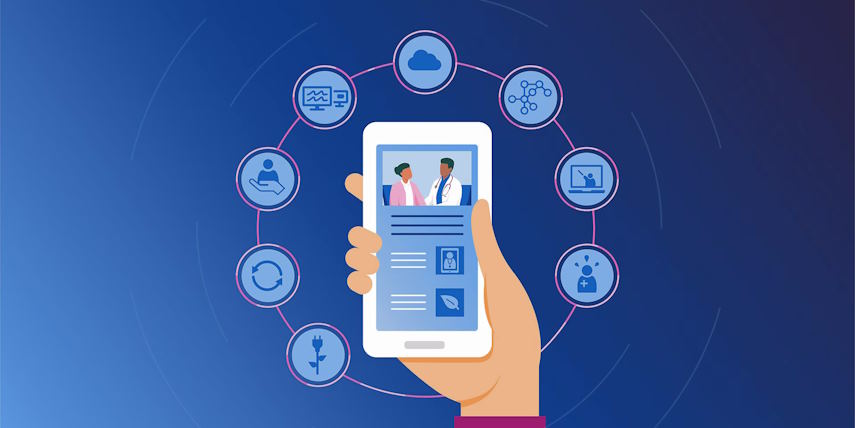
The COVID-19 pandemic shook the world, leaving no nation untouched by its devastating impact. As countries grappled with the unprecedented challenges posed by the health crisis, a beacon of hope emerged in the form of innovative technological solutions. From the healthcare sector’s transformation with telemedicine and AI-driven drug discovery to the digital revolution in education and the rapid evolution of e-commerce and supply chain logistics, technology played a pivotal role in aiding countries on their path to recovery. Embracing the power of innovation and adaptability, nations worldwide harnessed the potential of cutting-edge technologies to not only mitigate the immediate effects of the pandemic but also pave the way for a more resilient and tech-driven future.
Technology-Enabled Healthcare Advancements
In the face of the COVID-19 pandemic, the healthcare sector experienced an unprecedented transformation, rapidly adopting innovative technological solutions to navigate through the challenges. From telemedicine to AI-driven advancements and IoT devices, technology played a pivotal role in revolutionizing healthcare and improving patient outcomes.
Telemedicine and Remote Patient Monitoring
- Telemedicine Bridging the Gap during Lockdowns:
As lockdowns and social distancing measures took hold, in-person healthcare visits became limited, risking the continuity of care for millions of patients. However, telemedicine emerged as a game-changer, bridging the gap between healthcare providers and patients. Through video consultations and virtual appointments, patients could receive medical advice, prescription refills, and even mental health support from the safety and comfort of their homes. Telemedicine not only ensured uninterrupted access to healthcare but also helped to minimize the burden on hospitals and clinics, reducing the risk of virus transmission.
- Benefits of Remote Patient Monitoring for Vulnerable Populations:
For vulnerable populations, such as the elderly and those with chronic illnesses, remote patient monitoring proved to be a lifeline. IoT-powered devices enabled continuous monitoring of vital signs and health parameters, providing real-time data to healthcare professionals. This allowed for early detection of any concerning changes, enabling timely interventions and preventing potential complications. Remote patient monitoring also eased the strain on healthcare facilities, freeing up beds and resources for more critical patients, while simultaneously empowering individuals to take an active role in managing their health.

AI and Data Analytics in Healthcare
- Predictive Modeling for Hospital Resource Allocation:
With hospitals facing overwhelming patient numbers during the peak of the pandemic, AI-driven predictive modeling became indispensable. These models analyzed data on infection rates, hospitalizations, and available resources to forecast demand accurately. By predicting COVID-19 hotspots and patient surges, hospitals could proactively allocate staff, equipment, and beds, ensuring optimal patient care and resource utilization.
- AI-Driven Drug Discovery and Vaccine Development:
In the race to find effective treatments and vaccines, AI and data analytics played a critical role in accelerating the research process. AI algorithms analyzed vast datasets, enabling researchers to identify potential drug candidates and understand the virus’s behavior better. Moreover, AI-supported vaccine development efforts led to the rapid creation of safe and effective vaccines, providing hope for a quicker end to the pandemic.
E-Commerce and Supply Chain Innovations
The COVID-19 pandemic triggered an unprecedented surge in the adoption of e-commerce, revolutionizing the way goods are bought and sold. As countries imposed lockdowns and restrictions, consumers turned to online shopping and digital payments for their daily needs. This rapid shift not only propelled the growth of e-commerce giants but also presented both challenges and opportunities for small businesses.
Rise of E-Commerce during the Pandemic
- Accelerated Adoption of Online Shopping and Digital Payments:
The pandemic acted as a catalyst for the widespread acceptance of online shopping and digital payments. With physical retail outlets temporarily closed or operating with limited capacity, consumers flocked to e-commerce platforms to purchase everything from groceries to electronics. This surge in demand led to innovations in digital payment systems, offering secure and contactless transactions that further boosted consumer confidence in online shopping.

- Challenges and Opportunities for Small Businesses:
While established e-commerce players thrived during the pandemic, small businesses faced a unique set of challenges and opportunities. On one hand, they struggled to compete with larger retailers and adapt to the sudden shift in consumer behavior. On the other hand, e-commerce presented an opportunity for smaller enterprises to expand their reach beyond local markets and connect with a broader customer base. Those who embraced digital transformation and provided seamless online experiences were better positioned to survive and thrive in the new normal.
Contactless Delivery and Automation
- Reducing Human Contact to Curb the Spread of the Virus:
In response to health concerns, contactless delivery became a standard practice in the e-commerce industry. Delivery personnel adopted safety protocols, ensuring no physical contact during the delivery process. Customers welcomed this approach, appreciating the added layer of protection during the pandemic.
- Utilizing Robotics and Autonomous Vehicles for Efficient Logistics:
Automation played a vital role in enhancing the efficiency of the supply chain. E-commerce companies increasingly turned to robotics and autonomous vehicles for tasks like order picking, packing, and last-mile deliveries. These technologies not only expedited delivery times but also reduced the reliance on human labor, addressing potential workforce disruptions caused by the pandemic.

